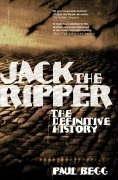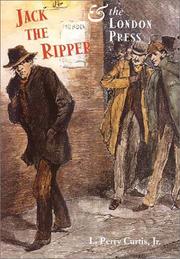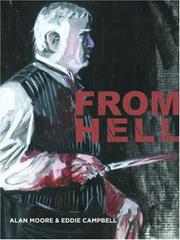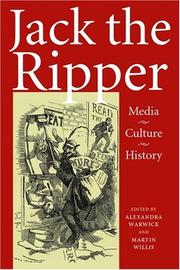| Listing 1 - 7 of 7 |
Sort by
|

ISBN: 1317866320 1315834928 1317866339 1281384682 9786611384685 1408211629 9781317866329 1405807121 9781405807128 058250631X 9780582506312 9781315834924 9781317866312 9781138140998 1429825308 Year: 2013 Publisher: London ; New York : Routledge,
Abstract | Keywords | Export | Availability | Bookmark
 Loading...
Loading...Choose an application
- Reference Manager
- EndNote
- RefWorks (Direct export to RefWorks)
'The clearest, most accurate, and most up-to-date account of the Ripper murders, by one of Britain's greatest and most respected experts on the ""autumn of terror"" in Victorian London.' William D. Rubenstein, Professor of Modern History, University of Wales, AberystwythEngland in the 1880s was a society in transition, shedding the skin of Victorianism and moving towards a more modern age. Promiscuity, moral decline, prostitution, unemployment, poverty, police inefficiency... all these things combined to create a feeling of uncertainty and fear.The East End of Lo
Serial murders --- History --- Jack, --- Dzhek, --- Prisoner 1167 --- Ripper, Jack the --- Whitechapel (London, England) --- History.
Book
ISBN: 1443882062 9781443882064 9781443878180 1443878189 Year: 2015 Publisher: Newcastle upon Tyne, UK Cambridge Scholars Publishing
Abstract | Keywords | Export | Availability | Bookmark
 Loading...
Loading...Choose an application
- Reference Manager
- EndNote
- RefWorks (Direct export to RefWorks)
Out of the London fog, a mysterious stranger arrives on the Buntings' doorstep seeking lodgings and a kindly ear - but a horrifying secret lurks behind his gentlemanly façade. Can Mrs Bunting uncover the true nature of his strange obsessions and avert looming disaster for her family? Marie Belloc Lowndes's psychological thriller The Lodger (1913) was the first novelization of the infamous and still-unsolved "Jack the Ripper" murders of 1888. The novel transformed a sordid story of the London streets into a taut domestic tale of conflicted motivations, uncertain loyalty, and slow-burning terror
Serial murders --- Jack, --- Dzhek, --- Prisoner 1167 --- Ripper, Jack the --- Whitechapel (London, England)
Book
ISBN: 0300207077 9780300207071 9780300117202 0300117205 Year: 2014 Publisher: New Haven, CT
Abstract | Keywords | Export | Availability | Bookmark
 Loading...
Loading...Choose an application
- Reference Manager
- EndNote
- RefWorks (Direct export to RefWorks)
The number of women murdered and mutilated by Jack the Ripper is impossible to know, although most researchers now agree on five individuals. These five canonical cases have been examined at length in Ripper literature, but other contemporary murders and attacks bearing strong resemblance to the gruesome Ripper slayings have received scant attention. These unsolved cases are the focus of this intriguing book. The volume devotes separate chapters to a dozen female victims who were attacked during the years of Jack the Ripper's murder spree. Their terrible stories-a few survived to bear witness, but most died of their wounds-illuminate key aspects of the Ripper case and the period: the gangs of London's Whitechapel district, Victorian prostitutes, the public panic inspired by the crimes and fueled by journalists, medical practices of the day, police procedures and competency, and the probable existence of other serial killers. The book also considers crimes initially attributed to Jack the Ripper in other parts of Britain and the world, notably New York, Jamaica, and Nicaragua. In a final chapter, the drive to find the identity of the Ripper is examined, looking at contemporary and later suspects as well as several important theories, revealing the lengths to which some have gone to claim success in identifying Jack the Ripper.
Serial murders --- Victims of crimes --- Crime victims --- Victimology --- Victims --- History --- Jack, --- Dzhek, --- Prisoner 1167 --- Ripper, Jack the --- Whitechapel (London, England) --- History.

ISBN: 1281722863 9786611722869 0300133693 9780300133691 9781281722867 0300088728 9780300088724 Year: 2001 Publisher: New Haven Yale University Press
Abstract | Keywords | Export | Availability | Bookmark
 Loading...
Loading...Choose an application
- Reference Manager
- EndNote
- RefWorks (Direct export to RefWorks)
Press coverage of the 1888 mutilation murders attributed to Jack the Ripper was of necessity filled with gaps and silences, for the killer remained unknown and Victorian journalists had little experience reporting serial murders and sex crimes. This engrossing book examines how fourteen London newspapers-dailies and weeklies, highbrow and lowbrow-presented the Ripper news, in the process revealing much about the social, political, and sexual anxieties of late Victorian Britain and the role of journalists in reinforcing social norms. L. Perry Curtis surveys the mass newspaper culture of the era, delving into the nature of sensationalism and the conventions of domestic murder news. Analyzing the fourteen newspapers-two of which emanated from the East End, where the murders took place-he shows how journalists played on the fears of readers about law and order by dwelling on lethal violence rather than sex, offering gruesome details about knife injuries but often withholding some of the more intimate details of the pelvic mutilations. He also considers how the Ripper news affected public perceptions of social conditions in Whitechapel.
Serial murderers --- Serial murders --- Multicide --- Multiple murder --- Murders, Serial --- Repetitive homicide --- Serial killing --- Serial killings --- Murder --- Multiple murderers --- Repetitive murderers --- Serial killers --- Murderers --- Press coverage --- History --- Jack, --- Dzhek, --- Prisoner 1167 --- Ripper, Jack the

ISBN: 0958578346 Year: 2000 Publisher: Paddington Eddie Campbell Comics
Abstract | Keywords | Export | Availability | Bookmark
 Loading...
Loading...Choose an application
- Reference Manager
- EndNote
- RefWorks (Direct export to RefWorks)
Legendary comics writer Alan Moore and artist Eddie Campbell have created a gripping, hallucinatory piece of crime fiction about Jack the Ripper. Detailing the events that led up to the Whitechapel murders and the cover-up that followed, From Hell has become a modern masterpiece of crime noir and historical fiction.
Alan Moore writer ; Eddie Campbell artist ; Pete Mullins contributing artist --- Campbell Eddie --- Moore Alan --- Mullins Pete --- Jack the Ripper --- Sickert Walter --- moordverhalen --- tekenverhaal --- 741.571 MOORE --- beeldverhaal --- Groot-Brittannië --- Londen --- negentiende eeuw --- strips --- Jack, --- Dzhek, --- Prisoner 1167 --- Ripper, Jack the --- English literature --- graphic novels --- Jack

ISBN: 9780719074936 0719074932 0719074940 9780719074943 Year: 2007 Publisher: Manchester ; New York Manchester University Press
Abstract | Keywords | Export | Availability | Bookmark
 Loading...
Loading...Choose an application
- Reference Manager
- EndNote
- RefWorks (Direct export to RefWorks)
Serial murders --- Serial murders in mass media. --- Serial murderers in literature. --- Serial murderers --- Whitechapel (London, England) --- Multiple murderers --- Repetitive murderers --- Serial killers --- Murderers --- Mass media --- Multicide --- Multiple murder --- Murders, Serial --- Repetitive homicide --- Serial killing --- Serial killings --- Murder --- History --- Social aspects. --- Jack, --- Dzhek, --- Prisoner 1167 --- Ripper, Jack the --- Influence. --- Serial murders in mass media --- Serial murderers in literature --- Social aspects
Book
ISBN: 1137599987 1137599995 Year: 2016 Publisher: London : Palgrave Macmillan UK : Imprint: Palgrave Macmillan,
Abstract | Keywords | Export | Availability | Bookmark
 Loading...
Loading...Choose an application
- Reference Manager
- EndNote
- RefWorks (Direct export to RefWorks)
In 1888 the name Jack the Ripper entered public consciousness with the brutal murders of women in the East End of London. The murderer was never caught, yet film and television depicts a killer with a recognisable costume, motive and persona. This book examines the origins of the screen presentation of the four key elements associated with the murders –Jack the Ripper, the victims, the detective and Whitechapel. Nineteenth-century history, art and literature, psychoanalytical theories of Freud and Jung and feminist film theory are all used to deconstruct the representation of Jack the Ripper on screen. .
Literature. --- Motion pictures --- Civilization --- Comparative literature. --- Literature --- Technology in literature. --- Comparative Literature. --- Literary History. --- Literature and Technology/Media. --- Film History. --- Cultural History. --- History. --- History and criticism. --- Serial murderers in motion pictures. --- Jack, --- In motion pictures. --- Whitechapel (London, England) --- Dzhek, --- Prisoner 1167 --- Ripper, Jack the --- Literature-History and criticism. --- Motion pictures-History. --- Civilization-History. --- Comparative literature --- Literature, Comparative --- Philology --- History and criticism --- Literature—History and criticism. --- Motion pictures—History. --- Civilization—History. --- England
| Listing 1 - 7 of 7 |
Sort by
|

 Search
Search Feedback
Feedback About UniCat
About UniCat  Help
Help News
News